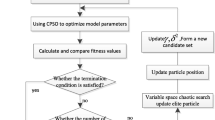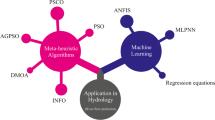Abstract
In order to study the parameter setting of load forecasting model of mobile communication adjacent base station, the particle swarm optimization algorithm is used to make intelligent optimization of the parameter values in the support vector regression model, so as to obtain a prediction model with better parameters. Through the verification of base station load prediction scheme assisted by the nearest neighbor base station, we establish the support vector regression model only using the base station itself historical information that introducing adjacent base station historical information, and compare the performance of the two parts. It is proved that the base station assisted load prediction scheme with assisted adjacent base stations can achieve better performance.









Similar content being viewed by others
References
Wang, G. G., Hossein Gandomi, A., Yang, X. S., et al. (2014). A novel improved accelerated particle swarm optimization algorithm for global numerical optimization. Engineering Computations, 31(7), 1198–1220.
Ishaque, K., & Salam, Z. (2013). A deterministic particle swarm optimization maximum power point tracker for photovoltaic system under partial shading condition. IEEE Transactions on Industrial Electronics, 60(8), 3195–3206.
Zheng, Z., Jeong, H. Y., Huang, T., et al. (2017). KDE based outlier detection on distributed data streams in multimedia network. Multimedia Tools and Applications, 76(17), 18027–18045. https://doi.org/10.1007/s11042-016-3681-y.
Gandomi, A. H., Yun, G. J., Yang, X. S., et al. (2013). Chaos-enhanced accelerated particle swarm optimization. Communications in Nonlinear Science and Numerical Simulation, 18(2), 327–340.
Shi, X., Zheng, Z., Zhou, Y., Jin, H., He, L., Liu, B., & Hua, Q.S. (2017). Graph processing on GPUs: A survey. (Vol. 50, pp.35). ACM Computing Surveys.
Regulski, P., Vilchis-Rodriguez, D. S., Djurović, S., et al. (2015). Estimation of composite load model parameters using an improved particle swarm optimization method. IEEE Transactions on Power Delivery, 30(2), 553–560.
Zheng, Z., Huang, T., Zhang, H., et al. (2016). Towards a resource migration method in cloud computing based on node failure rule. Journal of Intelligent & Fuzzy Systems, 31(5), 2611–2618.
Faria, P., Vale, Z., Soares, J., et al. (2013). Demand response management in power systems using particle swarm optimization. IEEE Intelligent Systems, 28(4), 43–51.
Delice, Y., Aydoğan, E. K., Özcan, U., et al. (2017). A modified particle swarm optimization algorithm to mixed-model two-sided assembly line balancing. Journal of Intelligent Manufacturing, 28(1), 23–36.
Zheng, Z., & Zheng, Z. (2017). Towards an improved heuristic genetic algorithm for static content delivery in cloud storage. Computers & Electrical Engineering. https://doi.org/10.1016/j.compeleceng.2017.06.011.
Nanchian, S., Majumdar, A., & Pal, B. C. (2017). Three-phase state estimation using hybrid particle swarm optimization. IEEE Transactions on Smart Grid, 8(3), 1035–1045.
Kavousi-Fard, A., Samet, H., & Marzbani, F. (2014). A new hybrid modified firefly algorithm and support vector regression model for accurate short term load forecasting. Expert Systems with Applications, 41(13), 6047–6056.
Esmin, A. A. A., Coelho, R. A., & Matwin, S. (2015). A review on particle swarm optimization algorithm and its variants to clustering high-dimensional data. Artificial Intelligence Review, 44(1), 23–45.
Biswas, S., Das, S., Debchoudhury, S., et al. (2014). Co-evolving bee colonies by forager migration: A multi-swarm based Artificial Bee Colony algorithm for global search space. Applied Mathematics and Computation, 232, 216–234.
Acknowledgements
We thank the anonymous reviewers and the editors for the valuable feedback on earlier versions of this paper. This paper is supported by the National Statistical Science Research Project of China, under Grant Number 2015LY43.
Author information
Authors and Affiliations
Corresponding author
Rights and permissions
About this article
Cite this article
Wang, T., Wang, M. Parameter Setting of Load Forecasting Model for Adjacent Base Stations of Mobile Communication Based on Particle Swarm Optimization. Wireless Pers Commun 102, 1057–1071 (2018). https://doi.org/10.1007/s11277-017-5139-6
Published:
Issue Date:
DOI: https://doi.org/10.1007/s11277-017-5139-6




